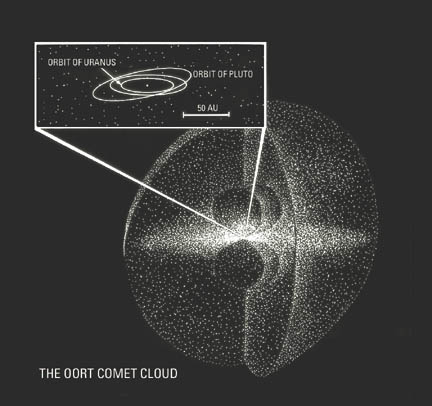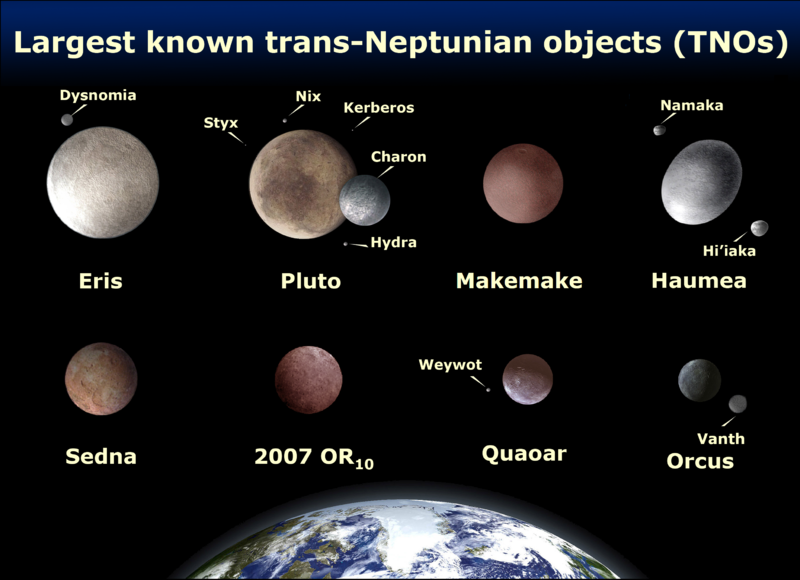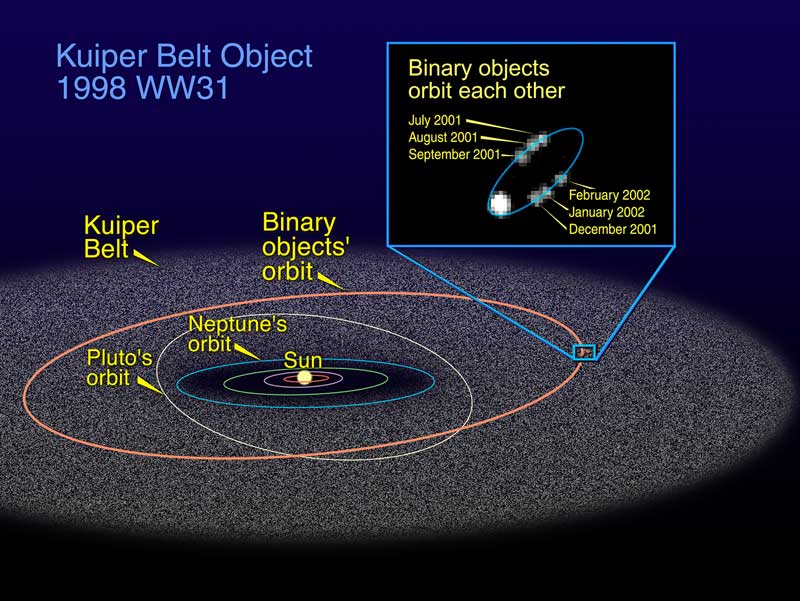April 15 lecture
The Kuiper Belt
The Kuiper Belt is a relatively
recent development in planetary science. Although long theorized,
the first KBO was not discovered until 1992. Now there are
thousands of known objects. There are several important classes:
- Centaurs are objects that orbit between Jupiter and
Neptune.
- Classical KBOs are the "main belt" of the Kuiper Belt,
well outside the orbit of Neptune (which is at 30 AU). They are
in relatively circular, co-planar orbits between 40 AU and 47 AU
from the Sun.
- Plutinos, or "little Plutos," occupy the 3:2 resonance
with Neptune, at 39.4 AU from the Sun. That is, Plutinos orbit
the Sun exactly twice for every 3 Neptune orbits. Pluto, of
course, is in this same resonance. This relationship gives
Plutinos a certain amount of stability, even though their orbits
can be very eccentric and inclined. A few KBOs can also be found
in the 2:1 resonance with Naptune, at 47.7 AU from the Sun.
These objects have been dubbed "Twotinos".
- Scattered KBOs are in much more eccentric orbits than
the Classical KBOs, but are not in any resonance like the
Plutinos. They are probably former Classical KBOs that have been
ejected from their nice-and-tidy orbits by an encounter with
Neptune.
From
Wikipedia:

Known
objects in the Kuiper belt. Objects in the main belt are green,
while scattered objects are orange. The four outer planets (J,
S, U, N) are blue. Neptune's few known Trojan asteroids are
yellow, while Jupiter's are pink. The scattered objects between
the Sun and the Kuiper belt are known as centaurs. The scale is
in astronomical units. The pronounced gap at the bottom is due
to obscuration by the band of the Milky Way.
Outer
solar system animation (5.0 MB -- Better to download rather than
play on your browser)
| Symbols in the animation |
| Red circles |
Classical KBOs |
| White circles |
Plutinos |
| Magenta circles |
Scattered KBOs |
| Orange triangles |
Centaurs |
| Cyan triangles |
"High-eccentricity objects" |
| Blue squares (filled) |
Short-Period Comets |
| Blue squares (unfilled) |
Long-Period Comets |
The Oort Cloud
The Kuiper
Belt is one of the two main comet reservoirs; the other is the Oort Cloud. In 1950, Jan
Oort was the first to notice that long-period comets all have
closed orbits (that is, they don't come from interstellar space),
that their aphelion distance tends to cluster around 50,000 AU,
and that they don't have any preferred direction. Using these
observations, Oort hypothesized a comet reservoir that forms a
spherical shell around the Sun, with the greatest concentration at
50,000 AU. Although Oort Cloud objects are much too far from the
Sun to be observed, subsequent observations of comets have refined
the Oort Cloud model, and computerized models have helped to
explain its origin and structure.

Large Kuiper
Belt Objects
Some KBOs
have proven to be quite large, and at least one is larger than
Pluto.

The largest KBO so far discovered is Eris,
discovered in 2003, which is slightly larger than Pluto and has at
least one moon, Dysnomia. A year earlier, Quaoar was
discovered. At 1200 km diameter, it is nearly as large as
Charon (Pluto's moon) More info on
Quaoar. Other large KBOs have also been
discovered, driving home the point that not much is particularly
special about Pluto, except for the fact that it is one of the
larger KBOs.
| some large KBOs |
Diameter (km) |
Class |
Discovered |
| Pluto |
2320 |
Plutino |
1930 |
| Charon |
1270 |
Plutino (moon) |
1978 |
| Quaoar |
1200 +/- 200 |
Classical |
2002 |
| Ixion |
1065 +/- 165 |
Plutino |
2001 |
| Varuna |
900 +/- 140 |
Classical |
2000 |
Eris
|
2400 +/- 100 |
Scattered
|
2003 |
Multiple Kuiper
Belt Objects
One of the
most fascinating discoveries about the Kuiper Belt is that many of
them have one or more large moons. The first binary
KBO to be discovered is called 1998 WW31, and more
are now known. Each of these binaries is made up of two objects
orbiting one another, and it is difficult to say which one is the
"moon" and which is the "primary." WW31 is less than twice as
large as its companion! By comparison, Pluto (the next closest
thing to a "double planet") is 8 times more massive than its moon
Charon, while Earth is 80 times more massive than the Moon. On the
other hand, these binaries are nowhere near planet-size: the
combined mass of WW31 is 5,000 times smaller than the combined
Pluto and Charon.
Binary
KBOs can also have unusually high eccentricity. WW31 has one of
the more eccentric satellites in the known Solar System. The
separation between the two bodies varies by a factor of 10: from
4,000 to 40,000 km!

Theories of
Satellite Formation
Binary Kuiper
Belt Objects are like nothing else in the Solar System. Not only
is the "moon" practically as large as the "primary," but they can
have large eccentricity, moving quite far from each other while
remaining in orbit. In contrast, although some asteroids have also
been found to have moons, asteroid moons are always very close to
the asteroid they orbit, and much much smaller. Let's review the
three major ways to form a satellite:
- Co-Accretion -- Regular systems of satellites, like
those of Jupiter and Saturn, probably formed out of a
"mini-nebula," very similar to the larger nebula out of which
the whole Solar System formed.
- Re-Accretion of Impact Debris -- Asteroid moons are
probably the result of impact debris that was accelerated into
orbit. Once in orbit, a ring of debris can re-accrete into a
single moon. On a much larger scale, Earth's Moon (and possibly
Pluto's Charon) formed in essentially the same way.
- Capture -- An object from elsewhere in the Solar System
can be captured into orbit if something slows it down
while it is approaching. Neptune's Triton is probably a captured
KBO, having collided with (and obliterated) a pre-existing
Neptunian moon.
The method by
which binary KBOs are formed is still unknown, and all three of
these mechanisms are possibilities. They could have formed as
"twins" out of the solar nebula, they could be the result of a
large impact that split a KBO in two, or they could be the result
of capture. Like many things about the Kuiper Belt, this is an
ongoing frontier of research.




